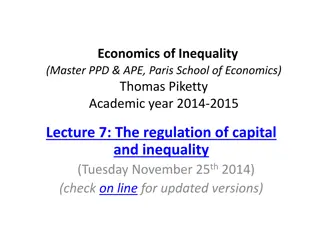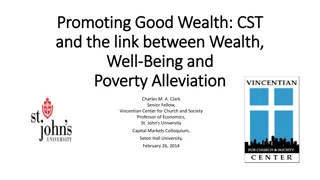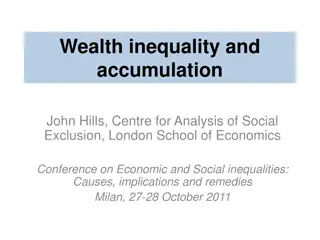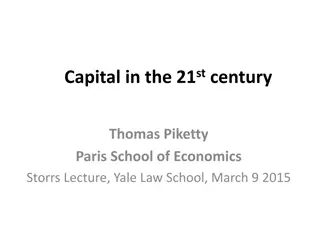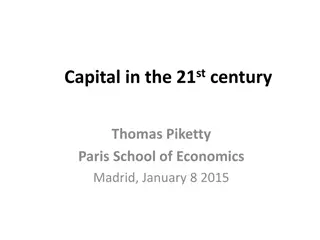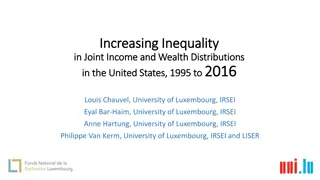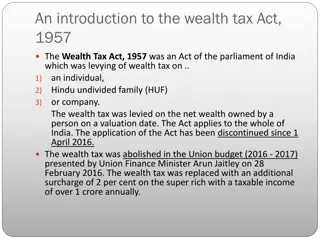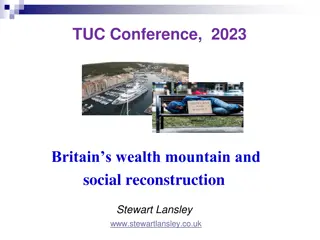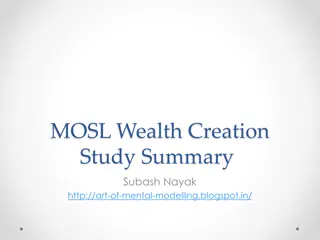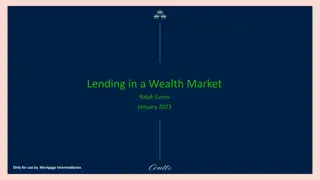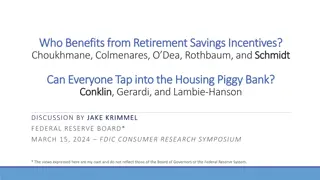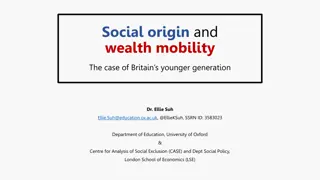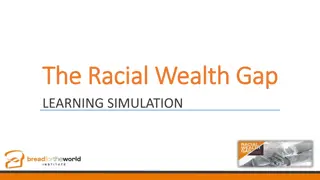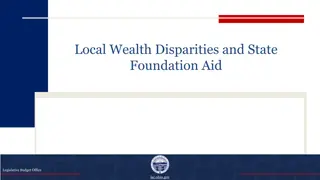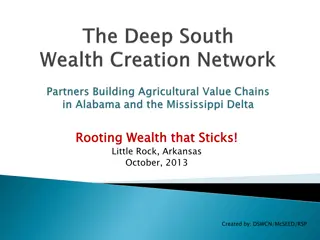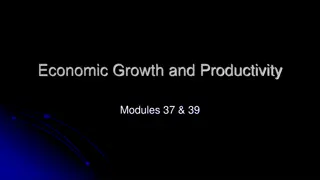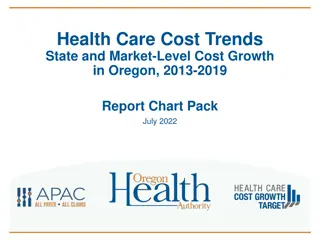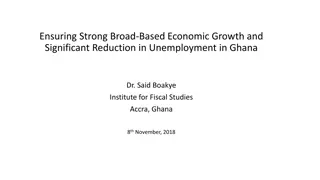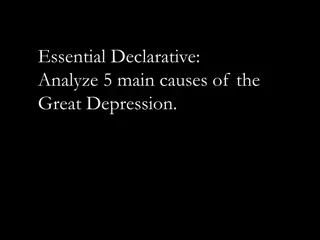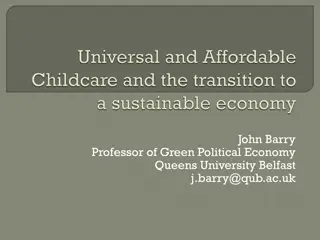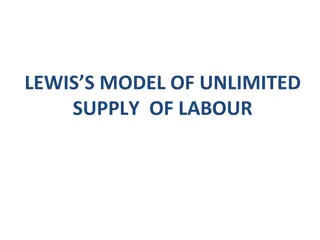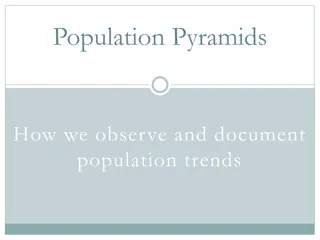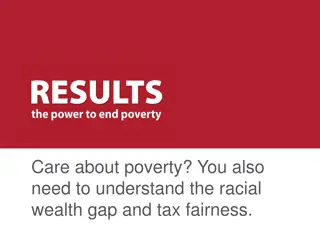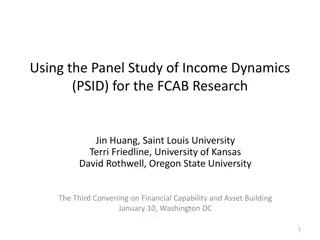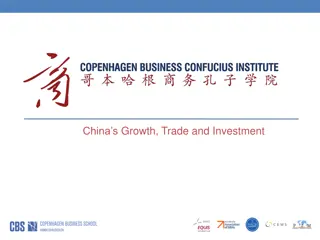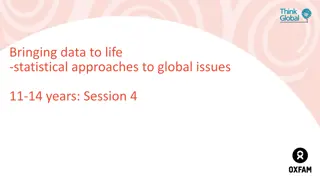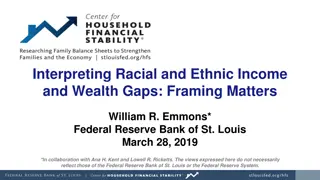Insights on Wealth Distribution and Economic Growth Trends
The surveyed perceptions versus the reality of wealth distribution in the U.S., alongside projected economic growth trends, highlight growing wealth inequality and potential social tensions. Piketty's key points emphasize the need for addressing these issues through increased government revenue and democratic discussions. The declining economic growth rates and world population projections further underscore the global challenges ahead.
Download Presentation

Please find below an Image/Link to download the presentation.
The content on the website is provided AS IS for your information and personal use only. It may not be sold, licensed, or shared on other websites without obtaining consent from the author. Download presentation by click this link. If you encounter any issues during the download, it is possible that the publisher has removed the file from their server.
E N D
Presentation Transcript
Distribution of Wealth U.S. Survey: What they would like it to be Survey: What they believe it to be Reality: What it is Where is the bottom 40%? http://harvardmagazine.com/2011/11/what-we-know-about-wealth
Reality: Distribution of Wealth U.S. Bracket Wealth Owned Top 20% 2nd 20% 3rd 20% 4th 20% 5th 20% 84.8% 10.9% 4.0% 0.2% 0.1%
Pikettys core points: A A. . Global economic growth is slowing. Wealth inequality will increase. Social tensions will likely increase. B B. . Peaceful remedies to increasing social tension require increased government revenue. C C. Democratic societies need serious discussion when choosing the best remedies. .
Projected Decline of Economic Growth in 21st Century Figure 2.5. The growth rate of world output from Antiquity until 2100 5.0% Projections (central scenario) 4.5% Observed growth rates 4.0% Growth rate of world GDP 3.5% 3.0% 2.5% 2.0% 1.5% 1.0% PROJECTION TO 2100 0.5% 0.0% 0-1000 1000-1500 1500-1700 1700-1820 1820-1913 1913-1950 1950-1990 1990-2012 2012-2030 2030-2050 2050-2070 2070-2100 The growth rate of world output surpassed 4% from 1950 to 1990. If the convergence process goes on it will drop below 2% by 2050. Sources and series: see piketty.pse.ens.fr/capital21c.
World Economic Growth Projected decline Output Population 1700-1820 0.5% 0.4 (80%) 1820-1913 1.5% 0.6 (40%) 1913-2012 3.0% 1.4 (47%) 2012-2100 2.0% 0.4 (21%) Technological Productivity 0.1 (20%) 0.9 (60%) 1.6 (53%) 1.6 (79%) 1950-2012 3.8% 1.9 (50%) 1.9 (50%)
World Population Growth Projected decline Figure 2.2. The growth rate of world population from Antiquity to 2100 2,0% 1,8% Observed growth rates 1,6% World population growth rate W 1,4% UN projections (central scenario) 1,2% 1,0% 0,8% 0,6% , 0,4% 0,2% 0,0% 0-1000 1000- 1500 1500- 1700 1700- 1820 1820- 1913 1913- 1950 1950- 1970 1970- 1990 1990- 2012 2012- 2030 2030- 2050 2050- 2070 2070- 2100 The growth rate of world population was above 1% per year from 1950 to 2012 and should return toward 0% by the end of the 21st century. Sources and series: see piketty.pse.ens.fr/capital21c. PROJECTION TO 2100
Population Growth 2050-2100: World 0.2% Europe - 0.1% America 0.0% Africa 1.0% Asia -0.2%
Economic Growth: 1.5% ( middle scenario predicted global economic growth rate 2050-2100)
Historically: - The slower the economic growth, the greater the capital/ income (and therefore the greater the inequality of capital ownership.) ratio smaller the capital/income therefore the smaller the inequality of capital ownership.) - The faster the economic growth, the ratio (and
Slow growing economies Fast growing economies Profit from capital reinvested in wage producing jobs less more Profit from capital accumulated as savings more less Capital/income ratio: rises declines
Capital and Wealth: Any asset that can be owned and exchanged in some market. National Income: A year s worth of GDP Composed of: Income from Labor (wage) Income from Capital (rent)
Historically, the higher the capital / income ratio, the greater the inequality of wealth. Share of Private Capital Owned by Different Wealth Segments in: (Europe ) (Scandinavia) 1910: The ratio: 700% (USA) 2010: 500% 1970: 250% Wealth Distribution Top 10% Middle 40% 5% Bottom 50% 5% 90% 50% 40% 10% 70% 25% 5%
Piketty: The history of the distribution of wealth has always been deeply political it cannot be reduced to purely economic mechanisms (p. 20)
Distribution of Wealth U.S. Survey: What they would like it to be Survey: What they believe it to be Reality: What it is Where is the bottom 40%? http://harvardmagazine.com/2011/11/what-we-know-about-wealth
Post World War II Social Contract: Citizens accept private property In return for Massive increase social rights.
Social Rights: Education Health Care Retirement
1945 to 1975 France: Trente Gloriesuses Germany: Wirtschaftswunder Japan: Post WWII Economic Miracle The Four Tigers emerge U.S.: American dream
PRIVATE CAPITAL IN RICH COUNTRIES 1970-2010 Economic Growth slows; tax rates drop; privatization of public wealth
Income Inequality: Europe and U.S. 1900-2010 Income share of top ten percent
SHARE OF INHERITED WEALTH IN TOTAL WEALTH IN FRANCE PROJECTED TO 2100 PROJECTION TO 2100
To a total of $2.29 trillion http://www.forbes.com/sites/kerryadolan/2014/09/29/inside-the-2014-forbes-400-facts-and-figures-about-americas-wealthiest/
35 + 36 + 38 + 42 + 42 + 50 + 67 + 81 = $391 BILLION
The Walton Family Wealth is more than the bottom X% in the USA 2007: X = 31% 2014: X = 41%
Percent of New Growth Captured by the top 1% 1993-2012: 68% 2009-2012: 95% (recovery)
r: return on capital Expected rate ~ 5% Expected rate ~ 1.5% g: growth of economy IMPACT OF r > g
RATE OF RETURN vs. GROWTH RATE AT WORLD LEVEL From Antiquity until 2100
After Tax Rate of Return vs. Growth Rate at World Level, From Antiquity until 2100
Advantages of a wealth tax discussion: -Avoid protectionism - Set a standard against which to judge other strategies. -An impetus to gather complete data on global wealth. - An impetus to take at least baby steps to international standards
An EU Wealth Tax? Below 1 million Euros - Between 1 and 5 million Euros - Above 5 million Euros - 0% 1% 2%


